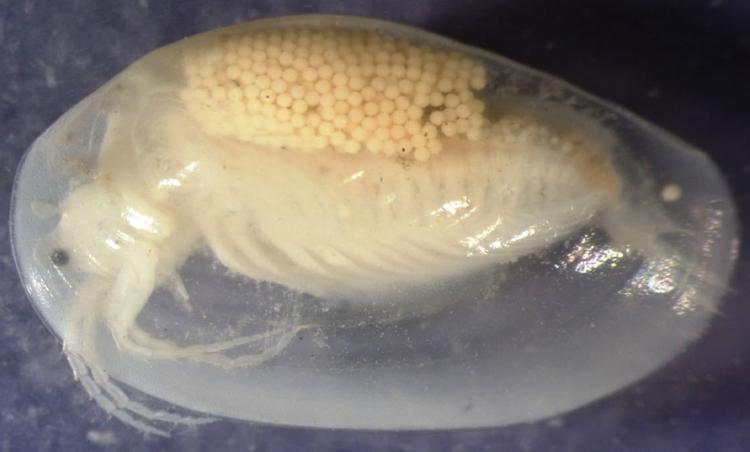CHARLOTTE AMALIE — Water hazards are something to watch out for on a golf course.
But in academics, a water hazard is a place to be explored, not avoided. Because in academia, the whole world is your oyster.
So it is only fitting that local scholars made a breakthough discovery of a new species of “clam-shrimp” on the Herman Moore Golf Course at the University of the Virgin Islands campus on St. Thomas.
According to a UVI news release, D. Christopher Rogers from the University of Kansas and Edwin Cruz-Rivera from UVI’s Department of Biological Sciences discovered the small crustaceans while working on a project to inventory freshwater animals on the island.
After comparing their specimens from UVI to other similar animals from museum collections, the researchers settled on the scientific name Eulimnadia insularis, which literally means “pleasant pond goddess from an island.”
“It is very surprising that we would find a new species on a university campus that has been in use for decades and has a thriving biology program,” Cruz-Rivera, associate professor of biology, said.
The finding underscores how much of the biodiversity in the Caribbean has yet to be discovered, even for areas that humans have been using for a long time.
“Relatively little is known about what freshwater animals are found on St. Thomas compared to St. Croix, St. John and Puerto Rico,” he said. “If you are trying to preserve an ecosystem, it is difficult to do if you don’t know exactly what you are trying to preserve.”
Clam shrimps are a group of small freshwater crustaceans with fossils dating back to the Devonian period around 390 million years ago. The aptly descriptive common name refers to the presence of a translucent hinged two-halved carapace, or shell, in which the animal can encase its body should it feel threatened. Underneath the delicate exterior, clam shrimps show many remarkable adaptations that have allowed them to survive for hundreds of millions of years.
“These curious animals live in environments that completely dry out seasonally. This would normally kill any population of small critters that breathe in water,” Cruz-Rivera and Rogers wrote in the peer-reviewed journal Zoological Studies in August. “Clam shrimps, however, have various tricks up their sleeve…or carapace. For starters, most populations are hermaphroditic, so every surviving adult individual in a pond can produce eggs and contribute to the next generation.”
The eggs themselves are remarkable. Aside from having intricate patterns of ridges and crests – in fact, the only reliable way of telling Eulimnadia species apart is by their shape – these strange eggs can lay dormant in dried out soil for decades and still be viable when the next rains come and fill their pool.
Clam shrimp and their relatives can capitalize quickly on any brief rainfall that can form a puddle. In Socotra Island, located in the Arabian Sea, a relative of clam shrimp called Branchipodopsis relicta can go from egg to reproductive adult in only four days, making it one of the fastest growing multicellular organisms on earth.
Drs. Cruz-Rivera and Rogers would like to see more students get involved in the study of freshwater systems. “There is still a lot to be learned about what organisms live in our ponds, guts, and even temporary habitats, such as bromeliads, which contain their own unique organisms,” he said. The two scientists will expand their research over the next five years as part of the Established Program to Stimulate Competitive Research (EPSCoR) “Ridge to Reef” grant aimed at addressing the impacts of changing environmental conditions on small island social-ecological systems.
A link to their article can be found here (http://zoolstud.sinica.edu.tw/Journals/59/59-42.pdf).
Funding from the Virgin Islands Water Resources Research Institute supported this work. For more information about UVI’s College of Science and Mathematics programs, visit www.uvi.edu.



